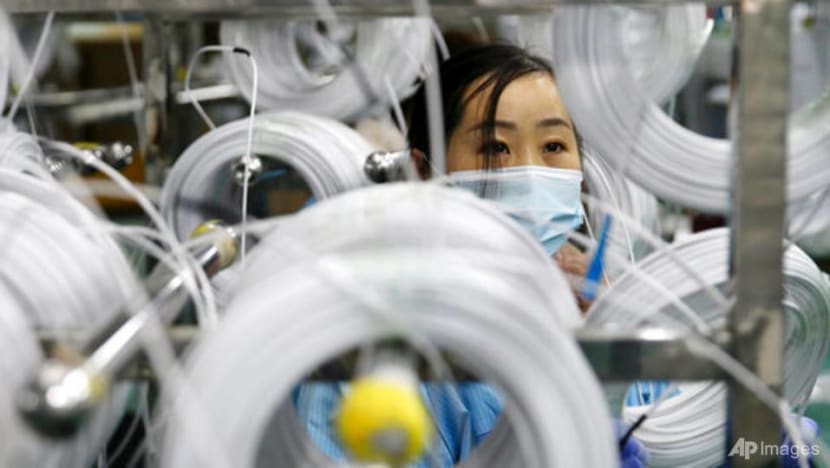Counting the cost as new COVID-19 waves disrupt supply chains in Asia
Asia is seeing a fresh wave of COVID-19 infections. What challenges does this pose for global supply chains and will these disruptions push up prices for consumers? Money Mind finds out.

As supply chains go offline and back online, observers worry that prices will go up because of disruption to the supplies of components and their final products. (Photo: AP)
SINGAPORE: Asia has seen fresh waves of COVID-19 cases in recent weeks, with countries implementing new measures to contain the spread of the pandemic.
This time round, the measures have been more targeted, unlike the blanket restrictions in the earlier waves.
But even as governments sought to balance between lives and livelihoods, industries continued to be affected by the scale and impact of the COVID-19 pandemic.
The new waves have hit many of Asia’s manufacturing hubs, with a spillover impact on supply chains as diverse as electronics and textiles.
“The issue is the unpredictability of what is happening. At different points in time, certain countries or certain regions or certain companies may be affected. And that is hard to plan for. It takes time for the parts of the supply chain to be turned on and off,” said Associate Professor Goh Puay Guan, analytics and operations department, NUS Business School.
READ: Strengthening supply chain resilience key to advancing economic integration: FM Balakrishnan
As supply chains go offline and back online, observers worry that prices will go up because of disruption to the supplies of components and their final products.
“Definitely the talk out there is about inflation. It is probably unavoidable. The question is to what extent the cost gets pushed to the consumer. Sometimes, companies may absorb some of the cost increase and pass on some to the consumer. So we do not know yet. But certainly, there have been price increases for products. Shipping costs have also gone up. So at some point in time, some parts of this would also get transferred to the consumers,” said Assoc Prof Goh.
In the longer run, the pandemic may prompt a redesign of supply chain models and push up prices further.
“Localised supply chains have higher reliability," said Shantanu Bhattacharya, Lee Kong Chian Professor of operations management at Singapore Management University.
"One of the biggest advantages of globalised supply chains was the constant reduction in pricing. But with supply chains spread out globally, will organisations, governments, and individual entities move to a model where you are willing to tolerate a higher price? So to some extent, I think consumers will have to tolerate a higher degree of inflation in the near future. Simply because you want a higher degree of reliability,” he added.
READ: Asia's factories sustain expansion, supply chain woes cloud outlook
In the post-pandemic new normal, Asia as a region will continue to be an important hub for manufacturing and global supply chains.
“One assumption is that supply chains are all about China, but that does not mean that other economies are not important. South Korea is very important, Taiwan is critical in the semiconductor industry and ASEAN is of growing importance," said Mr Sanjay Mathur, chief economist, Southeast Asia and India, at ANZ.
"Another misconception is that this is only about electronics. But if you look at the auto industry, or how garments are produced in Bangladesh or Vietnam – they are all part of supply chains. So this is a very important trend. It’s a circular trend that at least over the next two decades, is going to change,” he added.
And for businesses facing supply chain disruptions, resilience and agility will be key.
“Companies have learnt that they have to diversify. They have to have risk plans and buffer inventory and flexibility of supply sources in place. COVID-19 is somewhat unique because many parts of the world are affected at the same time," said Assoc Prof Goh.
VIDEO: Firms double down on AI, machine learning to keep supply chain running
Beyond COVID-19, analysts said broader trends will shape companies’ decisions to restructure and rebuild their supply chains.
This includes issues such as trade friction between the US and China, as well as substantial reskilling of the labour force amid automation, said Mr Mathur.
“Thirdly, a very important change we need to also understand is, how demand is going to change over the next few years," said Mr Mathur.
"It is getting very clear that China is becoming an increasingly dominant driver of growth, whereas other societies are maturing. ASEAN seems to be maturing at this point in time in terms of growth, in terms of demand in terms of sophistication. So do we need to shift our factories closer to Asia for Asian demand and that by itself requires a big change. So there’s a lot of structural forces behind how factories will look like, where they are located, and that will probably go way beyond what the pandemic.”














